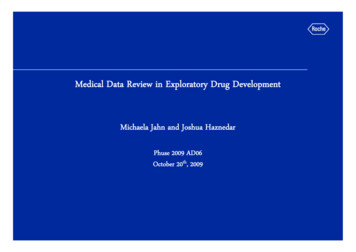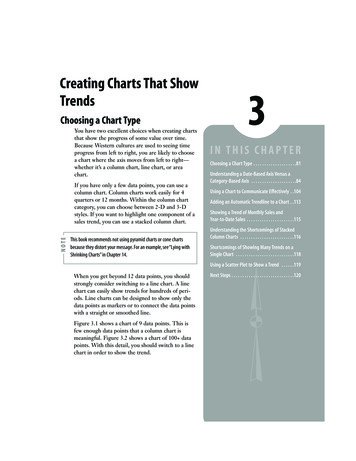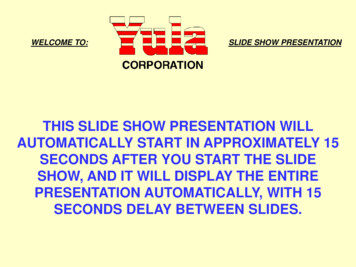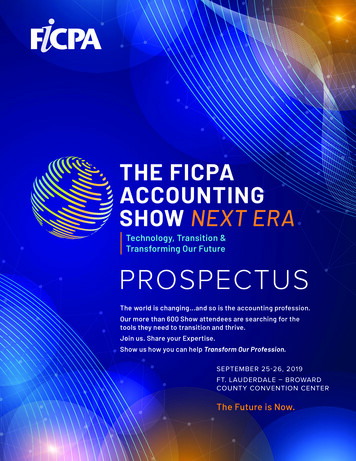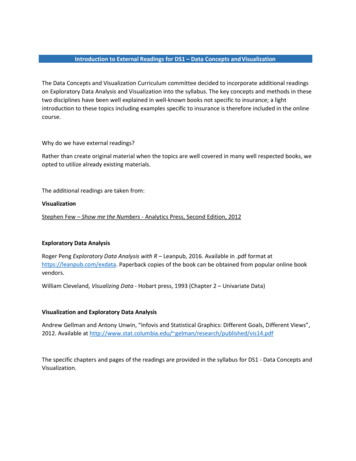
Transcription
Introduction to External Readings for DS1 – Data Concepts and VisualizationThe Data Concepts and Visualization Curriculum committee decided to incorporate additional readingson Exploratory Data Analysis and Visualization into the syllabus. The key concepts and methods in thesetwo disciplines have been well explained in well-known books not specific to insurance; a lightintroduction to these topics including examples specific to insurance is therefore included in the onlinecourse.Why do we have external readings?Rather than create original material when the topics are well covered in many well respected books, weopted to utilize already existing materials.The additional readings are taken from:VisualizationStephen Few – Show me the Numbers - Analytics Press, Second Edition, 2012Exploratory Data AnalysisRoger Peng Exploratory Data Analysis with R – Leanpub, 2016. Available in .pdf format athttps://leanpub.com/exdata. Paperback copies of the book can be obtained from popular online bookvendors.William Cleveland, Visualizing Data - Hobart press, 1993 (Chapter 2 – Univariate Data)Visualization and Exploratory Data AnalysisAndrew Gellman and Antony Unwin, “Infovis and Statistical Graphics: Different Goals, Different Views”,2012. Available at http://www.stat.columbia.edu/ gelman/research/published/vis14.pdfThe specific chapters and pages of the readings are provided in the syllabus for DS1 - Data Concepts andVisualization.
Notes on Visualizing Data, William S Cleveland, Chapter 2Visualizing Data by William Cleveland is a classic. Although published in 1993, it has stood the test oftime. Cleveland’s philosophy and approach to graphically exploring data, introduced in this book, arestill taught in statistics courses.Given the age of the book, however, please keep the following in mind: Graphs, although done on a computer, reflect the technology of the time.The text contains references to obsolete technology such as floppy disks.The data sets used for illustrating Exploratory Data Analysis (EDA) techniques are olderdata sets. Examples include heights of singers (1979) and fusion times in viewing astereogram (1975).The book predates the explosion in the use of open source tools such as R. Hence there areno data sets to download or R code to use for producing graphs.Peng’s Exploratory Data Analysis in R builds on the foundation laid by Cleveland and provides anintroduction to using modern tools and publicly available databases in EDA. But Cleveland covers someimportant topics that Peng does not. For instance, Cleveland contains a more extensive introduction toquantile/quantile plots and box plots and how they are used. Cleveland also provides a thoroughdiscussion of logarithmic and other transformations. The two books combined provide a morecomplete understanding of EDA and the tools we use today to pursue it.
Notes on R for Exploratory Data AnalysisThe primary reference selected for exploratory data analysis is Exploratory Data Analysis with R by RogerPeng. This book was chosen because it provides a practical discussion of most of the fundamentalapproaches to exploring and understanding data. It does assume some knowledge of R, but actual useof R code is not required to understand the EDA concepts Peng discusses. This document provides abrief introduction to some of the R language features used in Peng.Get bookA pdf copy of the book is available at: https://leanpub.com/exdataIn addition to purchasing the Peng book from an online retailer, it can also be purchased from Leanpub(http://leanpub.com/exdata).If you do not use R today, but would like to replicate some of the R code described in the book, followthe steps below in order to install R on your computer and to be able to use an R editor.Get dataSources for many of the data sets used in the book are documented in footnotes, so for many examplesyou will be able to download the data sets and work through the illustrations that are in the book.However, you can also download the data sets along with an electronic copy of the book from theLeanpub website. There will be a small charge for the data.Install R Go to www.r-project.orgClick on the CRAN link (on the left side of the screen). Select a CRAN mirror (i.e. one example inthe US is the Berkley site but there are many others in many countries)Download latest version of RThis will be an execute (.exe) fileClick it to install RWe recommend the RStudio editor.–Go to https://www.rstudio.com/–Download and install RStudio–Other editors such as word and Notepad can be used but you get a lot of addedfunctionality with RStudio
Install packages (such as dplyr)R packages provide many of the tools that can be used in exploratory data analysis. The Peng bookmakes a lot of use of the dplyr package (package and function names are italicized). This package mustbe installed in R before it can be used. The R software contains a tab for packages at the top. You needto click on this and select any packages you want installed. Alternatively, the tools menu in RStudioprovides an option for installment packages.Read dataTo read data using the read csv function as done by Peng you will need to install the readr adr/README.html .The data sets used by R are commonly stored in text files (i.e., space, tab, or comma delimited).Although Peng uses the read csv function to read in data, the read.table (and related read.csv ) functionis also commonly used. The following code would read comma delimited data from the file SampleDatain the directory Data, where the data file contains variable names in the first row.traindata -read.csv("C:/WPData/SampleData.csv" ,header TRUE)To get help on the use of the read.table (read.csv) functions, type ?read.table into your editor and runthe code or type it into the command line of R. This will bring up a help file that explains how to use thefunction.
R operations: ArithmeticR performs basic arithmetic operations of addition, subtraction, multiplication, and division, along withother common mathematical procedures as illustrated below. The syntax for performing the arithmeticoperations is the same or similar to that of many other programming languages. However, the basic unitfor any operation in R is a vector, which in the illustrations below is a vector of numbers. Thus, additionis performed by adding two vectors and multiplication by multiplying two vectors. This should be kept inmind when performing operations in R. Ideally, the vectors will be the same size; if not, R has rules forreplicating the elements of one vector to match the number in the other vector and R will issue awarning that the vectors are not the same size. x -c(1,2,3,4,5) y c(6,7,8,9,10)Note that in the example above both “ -“ and the can be used as the equal sign in an expression. Alsonote the ”c” or combine operator which is used to combine elements, in this case numbers, in a vector.The variables in the example are named x and y. In R, variable names are case sensitive so X and Ywould refer to different variables. In the examples below, R code is shown on lines beginning with agreater than symbol (“ ”), as this is how code appears in the command window of R. The results of Rcode after it has been run are also shown below. Note in the examples R output is shown in slightlylarger font.# add 2 variables z -x yThe pound sign is used for commenting:# print z by typing variable name and pressing enter. The result is indexed to [1] as it is the first lineprinted z[1]79 11 13 15# this is the same as print(z) print(z)[1]79 11 13 15 z x*y z[1]6 14 24 36 50
# square z z x 2 z[1]149 16 25# take natural log of z z log(x) z[1] 0.0000000 0.6931472 1.0986123 1.3862944 1.6094379Statistical operations.R has a number of statistical operations that are often used, including mean, standard deviation,variance, minimum, and maximum.Below are illustrations of applying the common statistical functions: mean (x)[1] 3 sd(x)[1] 1.581139 cor(x,y)[1] 1Type ? stats-packagefor more information on the statistics available in base R.Tabular summariesR has several important functions used to summarize data. In order to produce a frequency table or acrosstabulation, use the table function: class -c("A","B","B","A","A","C")# produce a frequency table table(class)
A B C3 2 1# produce a cross tabulation from two variables x2 -c(1,2,3,1,2,3) table(x2,class)classx2 A B C1 2 0 02 1 1 03 0 1 1In order to obtain a mean or other summary statistic by a grouping variable, use the tapply (table apply)function. The function requires a vector or list of numbers, a grouping variable, and the statistic desiredfor each group:x2.mean -tapply(x2,class,mean)x2.meanABC1.333333 2.500000 3.000000Use the help function to find out more about the tapply function and how to use it:?tapplydata framesThe most commonly used form of data when using R for data analysis is the data frame. A data framecan be created by using the “data.frame” function. The x2 and class vectors created, which are thesame length, can be combined into one data frame with the following code: test.data -data.frame(x2,class) test.datax2123456class123123ABBAACNow let’s see how many rows are in the data with the nrow function
nrow(test.data)[1] 6We can use the names functions to get the variable names of the variables in a dataframe. names(test.data)[1] "x2""class"Specific variables in a data frame can be referenced in several ways. The first is to reference the variableusing the “ ” symbol to reference the variable after the data frame name. class test.data classThe second is to use array index references. An element of a data frame can be referenced by its rowand column number within square brackets. To reference one cell of a data frame, reference the rowand column in square brackets: test.data[1,2][1] ATo reference a variable, i.e., all the rows of a given column, use: class test.data[,2] or class test.data[2] class[1] A B B A A CLevels: A B CWhen using the read.table or read.csv function to read in data, the data read in is by default a dataframe. Peng, beginning in Chapter 5 of Exploratory Data Analysis with R, makes heavy use of the readrpackage, as it is more efficient in reading in large data sets. You can use read csv, instead of read.csv.The result of using read csv is a tibble (table dataframe) which has some properties and features that Rdata frames do not have. To illustrate, we will read in some data (the first 10,000 rows of ozone data)used in chapter 5:# use read.csv to read data data -read.csv("C:/PengData/hourly 44201 2014.csv",nrows 25000) "Datum"
ier""Method.Name""County.Name"Now the read csv version:# use read csv to read data# install library readr install.packages("readr")# load library library(readr)# read in the ozone hourly data data2 -read csv("C:/PengData/hourly 44201 2014.csv",n max 25000) names(data2)[1] "State Code""County Code"[3] "Site Num""Parameter Code"[5] "POC""Latitude"[7] "Longitude""Datum"[9] "Parameter Name""Date Local"[11] "Time Local""Date GMT"[13] "Time GMT""Sample Measurement"[15] "Units of Measure""MDL"[17] "Uncertainty""Qualifier"[19] "Method Type""Method Name"[21] "State Name""County Name"[23] "Date of Last Change"The variable names have spaces in them in the data read in by read csv reflecting the variable names inthe original file. The read.csv converts the variable names to have a period rather than a space separatorseparating two words in a name. Under the tibble formatting convention the spaces in the variablenames are allowed, however you will need to utilize help functions about referencing variables withspaces in them. 1 In chapter 5, variables are referred to using variable names with periods rather thanspaces in them. There are two ways to change the variable names to remove the spaces.1. Use the names function per the example in Peng:names(data2) -make.names(data2))2. Use the data.frame function which will convert the data to a data frame with periods in thevariable name1In general, it is necessary to put quotes around the variable name as in data2 ’State Name’
data2 -data.frame(data2)Packages as sources of many functionsCertain R functions such as the mean function are available in base R. However, many of the R functionsdata scientists use are in R packages. For instance, the read csv function is contained in the R readrpackage. It is necessary to install the packages you will be needing before you can use them.One of the packages that Peng makes a lot of use of is the dplyr package. The dplyr package is a datamanagement package that has many of the same data management functions that SQL possesses andthat other R functions could be used for, though they are often less efficient. A good introduction to thedplyr package is provided in Chapter 4 2. Some of the dplyr functions include select() for selectingvariables from a database, filter() for selecting records from a database, arrange() for sorting records,and mutate() to produce transformations of variables. In addition, dplyr uses the pipe operator “% %” 3.The pipe operator is used to organize steps of data processing into one statement, as opposed to asequence of functions.The user will need to make sure all needed packages are installed before they start programming in R.In addition, to use a library (i.e., package), the library() function will need to be run before the code thatcalls functions from the package.R Quick Introduction ReferencesThe following R references are recommended for those who seek additional introductory informationabout R.Gareth J, Witten D, Hastie T., Tibshirani R, An Introduction to Statistical Learning with Applicati
Visualizing Data, William S Cleveland, Chapter 2 . Visualizing Data by William Cleveland is a classic. Although published in 1993, it has stood the test of time. Cleveland’s philosophy and approach to graphically exploring data, introduced in this book, are still taught in statistics courses.
